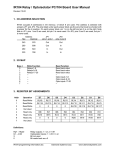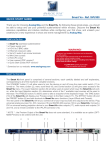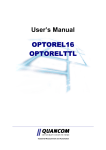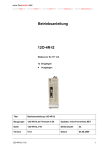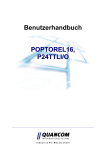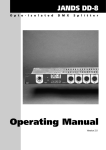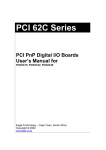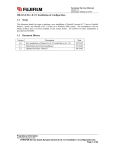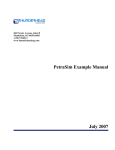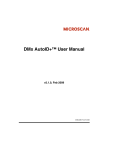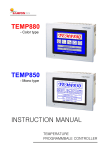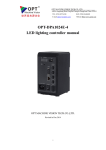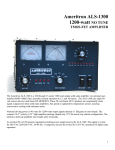Download OPMM-1616-XT User Manual - Diamond Systems Corporation
Transcript
init OPMM-1616-XT PC/104 I/O Module with Optoisolated inputs and Relay Outputs Rev 1.0 September 2010 Revision Date Comment 1.0 9/26/2010 first release FOR TECHNICAL SUPPORT PLEASE CONTACT: [email protected] Copyright 2010 Diamond Systems Corporation 1255 Terra Bella Ave. Mountain View, CA 94043 USA Tel 1-650-810-2500 Fax 1-650-810-2525 www.diamondsystems.com CONTENTS 1. 2. Important Safe Handling Information .............................................................................................................3 Introduction .......................................................................................................................................................4 2.1 Description .....................................................................................................................................................4 2.2 Features .........................................................................................................................................................4 3. Functional Overview .........................................................................................................................................5 3.1 Functional Block Diagram ..............................................................................................................................5 3.2 OPMM-1616-XT Board Drawing....................................................................................................................6 4. Connector Pinout and Pin Description ...........................................................................................................7 4.1 PC/104 (J1, J2) ..............................................................................................................................................7 4.2 Input (J3)........................................................................................................................................................7 4.3 Output (J4, J5) ...............................................................................................................................................8 5. Theory of Operation..........................................................................................................................................9 5.1 Input Circuits ..................................................................................................................................................9 5.2 Relay Outputs ................................................................................................................................................9 5.3 PC/104 Bus Interface ....................................................................................................................................9 5.4 Interrupts ..................................................................................................................................................... 10 5.5 LED Indicator .............................................................................................................................................. 10 6. Board Configuration ...................................................................................................................................... 11 6.1 Base Address and IRQ Jumper Settings .................................................................................................... 11 7. I/O Registers ................................................................................................................................................... 12 7.1 I/O Map Summary....................................................................................................................................... 12 7.2 I/O Register Details .................................................................................................................................... 13 7.2.1 Base address + 0 (0x00) Write Relay 7-0 Control Register ............................................................ 13 7.2.2 Base address + 0 (0x00) Read Relay 7-0 Status Register .............................................................. 13 7.2.3 Base address + 1 (0x01) Write Relay 15-8 Control Register .......................................................... 13 7.2.4 Base address + 1 (0x01) Read Relay 15 to 8 Status Register ........................................................ 14 7.2.5 Base address + 2 (0x02) Write Relay Select Register .................................................................... 14 7.2.6 Base address + 2 (0x02) Read Optoinput 7-0 Status Register ....................................................... 14 7.2.7 Base address + 3 (0x03) Write Board Reset Control Register ........................................................ 15 7.2.8 Base address + 3 (0x03) Read Optoinput 15-8 Status Register ..................................................... 15 7.2.9 Base address + 4 (0x04) Write Interrupt Control Register .............................................................. 15 7.2.10 Base address + 4 (0x04) Read Change Detect 7-0 Status Register ............................................... 16 7.2.11 Base address + 5 (0x05) Write LED Control Register ..................................................................... 16 7.2.12 Base address + 5 (0x05) Read Change Detect 15-8 Status Register ............................................. 16 8. Programming .................................................................................................................................................. 17 8.1 General Information .................................................................................................................................... 17 8.2 Reading an Opto Input ............................................................................................................................... 17 8.3 Turning Relays On and Off ......................................................................................................................... 18 8.3.1 Controlling Individual Relays ............................................................................................................. 18 8.3.2 Controlling Multiple Relays ................................................................................................................ 19 8.4 Interrupts ..................................................................................................................................................... 20 8.5 Other Software Commands ........................................................................................................................ 20 9. Specifications................................................................................................................................................. 21 OPMM-1616-XT User Manual Rev 1.0 www.diamondsystems.com Page 2 1. IMPORTANT SAFE HANDLING INFORMATION WARNING! ESD-Sensitive Electronic Equipment Observe ESD-safe handling procedures when working with this product. Always use this product in a properly grounded work area and wear appropriate ESD-preventive clothing and/or accessories. Always store this product in ESD-protective packaging when not in use. Safe Handling Precautions This board contains a high density connector with many connections to sensitive electronic components. This creates many opportunities for accidental damage during handling, installation and connection to other equipment. The list here describes common causes of failure found on boards returned to Diamond Systems for repair. This information is provided as a source of advice to help you prevent damaging your Diamond (or any vendor’s) embedded computer boards. ESD damage – This type of damage is usually almost impossible to detect, because there is no visual sign of failure or damage. The symptom is that the board eventually simply stops working, because some component becomes defective. Usually the failure can be identified and the chip can be replaced. To prevent ESD damage, always follow proper ESD-prevention practices when handling computer boards. Damage during handling or storage – On some boards we have noticed physical damage from mishandling. A common observation is that a screwdriver slipped while installing the board, causing a gouge in the PCB surface and cutting signal traces or damaging components. Another common observation is damaged board corners, indicating the board was dropped. This may or may not cause damage to the circuitry, depending on what is near the corner. Most of our boards are designed with at least 25 mils clearance between the board edge and any component pad, and ground / power planes are at least 20 mils from the edge to avoid possible shorting from this type of damage. However these design rules are not sufficient to prevent damage in all situations. A third cause of failure is when a metal screwdriver tip slips, or a screw drops onto the board while it is powered on, causing a short between a power pin and a signal pin on a component. This can cause overvoltage / power supply problems described below. To avoid this type of failure, only perform assembly operations when the system is powered off. Sometimes boards are stored in racks with slots that grip the edge of the board. This is a common practice for board manufacturers. However our boards are generally very dense, and if the board has components very close to the board edge, they can be damaged or even knocked off the board when the board tilts back in the rack. Diamond recommends that all our boards be stored only in individual ESD-safe packaging. If multiple boards are stored together, they should be contained in bins with dividers between boards. Do not pile boards on top of each other or cram too many boards into a small location. This can cause damage to connector pins or fragile components. Power supply wired backwards – Our power supplies and boards are not designed to withstand a reverse power supply connection. This will destroy each IC that is connected to the power supply (i.e. almost all ICs). In this case the board will most likely will be unrepairable and must be replaced. A chip destroyed by reverse power or by excessive power will often have a visible hole on the top or show some deformation on the top surface due to vaporization inside the package. Check twice before applying power! Overvoltage on digital I/O line – If a digital I/O signal is connected to a voltage above the maximum specified voltage, the digital circuitry can be damaged. On most of our boards the acceptable range of voltages connected to digital I/O signals is 0-5V, and they can withstand about 0.5V beyond that (-0.5 to 5.5V) before being damaged. However logic signals at 12V and even 24V are common, and if one of these is connected to a 5V logic chip, the chip will be damaged, and the damage could even extend past that chip to others in the circuit OPMM-1616-XT User Manual Rev 1.0 www.diamondsystems.com Page 3 2. INTRODUCTION 2.1 Description OPMM-1616-XT is a PC/104 I/O module with 16 optoisolated inputs and 16 relay outputs. 2.2 Features Optoisolated Inputs 16 unidirectional optoisolated inputs with current limiting resistors 30VDC input capacity 0-1.5V input = logic 0; 3-30VDC input = logic 1 Programmable edge detection with interrupts Relay Outputs 16 relay outputs Form C contacts (SPDT) 2A current capacity 30VDC / 30W switching capacity Bus Interface PC/104 8-bit ISA bus interface (both 8-bit and 16-bit connectors installed) 8 byte I/O footprint IRQ support Environmental / Mechanical PC/104 format board o o -40 C to +85 C operating temperature +5VDC input voltage OPMM-1616-XT User Manual Rev 1.0 www.diamondsystems.com Page 4 3. FUNCTIONAL OVERVIEW 3.1 Functional Block Diagram OPMM-1616-XT User Manual Rev 1.0 www.diamondsystems.com Page 5 3.2 OPMM-1616-XT Board Drawing J1 J2 J3 J4 J5 J6 OPMM-1616-XT User Manual Rev 1.0 Main PC/104 header 16-bit extension Optoisolated inputs Relays 0 to 7 Relays 8 to 15 Address and IRQ jumpers www.diamondsystems.com Page 6 4. CONNECTOR PINOUT AND PIN DESCRIPTION 4.1 PC/104 (J1, J2) Connectors J1 (PC/104) and J2 (16-bit extension) provide connection to the motherboard. 4.2 Input (J3) Connector J3 handles optoisolated inputs. In 0+ In 1+ In 2+ In 3+ In 4+ In 5+ In 6+ In 7+ In 8+ In 9+ In 10+ In 11+ In 12+ In 13+ In 14+ In 15+ NC J3: Input 1 2 3 4 5 6 7 8 9 10 11 12 13 14 15 16 17 18 19 20 21 22 23 24 25 26 27 28 29 30 31 32 33 34 In 0In 1In 2In 3In 4In 5In 6In 7In 8In 9In 10In 11In 12In 13In 14In 15NC Connector type: 0.1” pitch 34-pin dual row right-angle pin header Signal Name In n+ In nNC Definition High side of optoisolated input Low side of optoisolated input Unused pin OPMM-1616-XT User Manual Rev 1.0 www.diamondsystems.com Page 7 4.3 Output (J4, J5) Connectors J4, at the right edge of the board, and J5, at the left edge, handle outputs. Relay 0 NO Relay 0 NC Relay 1 C Relay 2 NO Relay 2 NC Relay 3 C Relay 4 NO Relay 4 NC Relay 5 C Relay 6 NO Relay 6 NC Relay 7 C NC J4: Relays 0 - 7 1 2 Relay 0 C 3 4 Relay 1 NO 5 6 Relay 1 NC 7 8 Relay 2 C 9 10 Relay 3 NO 11 12 Relay 3 NC 13 14 Relay 4 C 15 16 Relay 5 NO 17 18 Relay 5 NC 19 20 Relay 6 C 21 22 Relay 7 NO 23 24 Relay 7 NC 25 26 NC Connector type: 0.1” pitch 34-pin dual row right-angle pin header Signal Name Relay n NO Relay n C Relay n NC NC J5: Relays 8 - 15 Relay 8 NO 1 2 Relay 8 C Relay 8 NC 3 4 Relay 9 NO Relay 9 C 5 6 Relay 9 NC Relay 10 NO 7 8 Relay 10 C Relay 10 NC 9 10 Relay 11 NO Relay 11 C 11 12 Relay 11 NC Relay 12 NO 13 14 Relay 12 C Relay 12 NC 15 16 Relay 13 NO Relay 13 C 17 18 Relay 13 NC Relay 14 NO 19 20 Relay 14 C Relay 14 NC 21 22 Relay 15 NO Relay 15 C 23 24 Relay 15 NC NC 25 26 NC Connector type: 0.1” pitch 34-pin dual row right-angle pin header Definition Normally open contact (disconnected when power off or relay de-energized, connected to Common contact when relay energized) Common contact Normally closed contact (connected to Common contact when power off or relay de-energized, disconnected when relay energized) Unused pin OPMM-1616-XT User Manual Rev 1.0 www.diamondsystems.com Page 8 5. THEORY OF OPERATION This chapter provides an orientation to the functional architecture of blocks on the board. Additional details are in the register programming section and specific chapters on various blocks. 5.1 Input Circuits The board features 16 optoisolated digital inputs. The inputs are unidirectional and accept DC voltages up to 30VDC. An input voltage in the range of 0-1.5V will result in a logic low indication, and an input voltage in the range of 3-30V will result in a logic high indication. Inputs feature channel to channel and input to output isolation of 500V DC or AC. The components, layout, and trace spacing are designed to support this isolation rating. The inputs also feature a programmable edge detection circuit (change of state detection circuit) that can generate interrupts on any change on any input. The optoisolated inputs are accessed via a 34-pin .1” pitch right-angle pin header along the top edge of the board. The input circuit has the following design: 5.2 Relay Outputs The board features 16 DPDT (form C) relays with 30VDC / 2A (60W resistive) capacity. Each relay has a lifetime of 10,000,000 operations. When the board is powered off or the relay is de-energized, the C contact is connected to the NC contact, and when the relay is energized, the C contact is connected to the NO contact. The relay type is NAIS TX2-5 or equivalent. All relays power up in their de-energized position (C contact connected to NC contact). The relays are accessed via two 26-pin .1” pitch right-angle pin headers along the left and right edges of the board. 5.3 PC/104 Bus Interface The board interfaces to the PC/104 ISA bus using an 8-bit I/O interface controlled by a CPLD. The board occupies 8 bytes in I/O space. Its base address is selected with 6 jumpers that select 1 or 0 for address bits A9-4. System address bits A15-10 are 0 for the board. For enhanced ruggedness, all jumper options may be configured with 0-ohm resistors on the bottom side of the board in place of mechanical jumpers. These jumpers are oriented in the same position as the jumpers on the top side and their positions are labeled for easy identification. For examples, see Section 6.1. OPMM-1616-XT User Manual Rev 1.0 www.diamondsystems.com Page 9 5.4 Interrupts The design includes an interrupt circuit for generating ISA bus IRQs. The IRQ options are 3, 4, 5, 6, 7, 10, and 11. An additional jumper enables selection of the 1K ohm pull-down resistor required for PC/104 IRQ sharing. IRQ10 and IRQ11 are on the 16-bit connector, while the remaining IRQs are on the 8-bit connector. Thus a board without the 16-bit connector installed does not have access to IRQ10 and IRQ11. For example, see Section 6.1. 5.5 LED Indicator The board has one LED indicator, located to the right of J2, which turns ON upon power-up. The LED can be controlled via software using a register write command as explained in the software section of this manual. OPMM-1616-XT User Manual Rev 1.0 www.diamondsystems.com Page 10 6. BOARD CONFIGURATION The board address and interrupt values are set using jumpers on J6. 6.1 Base Address and IRQ Jumper Settings Address Pin positions on J6 in the address area labeled 9 through 4 are used together to select a base address for the board. The six pin positions are identified in the table below. A jumper plug in applies a 0 to that address bit, out is a 1. The base address is always 12 bits long. The lower four address bits are always 0, which means that the OPMM1616-XT board can only be configured on 16 byte boundaries. Also, the upper 2 bits (address bit 10 and bit 11) are also always zero which means that the maximum value in the MSB can only be 0011 or 3. The valid address range is from 0x0100 to 0x3F0. A board shipped from the factory is at default address of 300H. You may need to verify that this setting is compatible with your system. NOTE: The table information only suggests some possible addresses. Others are possible as long as the address is 100 hex or higher and the address range does not conflict with any other resource on the ISA bus. Header label for address pins Hex Decimal 9 8 7 6 5 4 100 256 in out 140 320 in out in in in in in out in in 180 384 in out out in in in 1C0 448 200 512 in out out out in in out in in in in in 240 576 out in in out in in 280 640 out in out in in in 300 (default) 768 out out in in in in 3F0 1016 out out out in in in IRQ Pin positions in the IRQ section of J6 and which are labeled 15 to 3 are for setting the IRQ value. 'R' is for selection of a 1kΩ pull-down resistor on the IRQ line. To select an IRQ, place a jumper block at the position next to the number of the desired IRQ on the board next to J6. To enable a pull-down resistor on the IRQ line (if no other device on the bus has one enabled), place a jumper on the 'R' position of J6. When using an IRQ, one (and only one) board in the system must have a pull-down resistor on the line. Examples of IRQ settings on J6: To enable IRQ5, place a jumper at position 5. Alternatively, to enable IRQ14, place a jumper at position 14. To disable use of a pull-down resistor for this board's IRQ, position 'R' should be unoccupied. OPMM-1616-XT User Manual Rev 1.0 www.diamondsystems.com Page 11 7. I/O REGISTERS 7.1 I/O Map Summary The board is controlled and monitored via eight 8-bit registers as defined below. Write Offset from base address 7 6 5 4 3 2 1 0 0 RLY7 RLY6 RLY5 RLY4 RLY3 RLY2 RLY1 RLY0 1 RLY15 RLY14 RLY13 RLY12 RLY11 RLY10 RLY9 RLY8 2 SET RESET R3 R2 R1 R0 3 BRDRST INTE1 INTE0 INTRST 4 5 LED 6 7 Read Offset 7 6 5 4 3 2 1 0 0 RLY7 RLY6 RLY5 RLY4 RLY3 RLY2 RLY1 RLY0 1 RLY15 RLY14 RLY13 RLY12 RLY11 RLY10 RLY9 RLY8 2 OPTO7 OPTO6 OPTO5 OPTO4 OPTO3 OPTO2 OPTO1 OPTO0 3 OPTO15 OPTO14 OPTO13 OPTO12 OPTO11 OPTO10 OPTO9 OPTO8 4 CHG7 CHG6 CHG5 CHG4 CHG3 CHG2 CHG1 CHG0 5 CHG15 CHG14 CHG13 CHG12 CHG11 CHG10 CHG9 CHG8 6 7 RLY15-0 Register bits: Controls the states of the 16 relays; the associated I/O pins match the value written to the registers. These register values may be read back. SET Command bit: Sets relay defined by R3-0 to 1. RESET Command bit: Sets relay defined by R3-0 to 0. R3-0 Data bits: Indicates the relay to set or reset with the SET and RESET commands. BRDRST Command bit: Resets all registers to 0. INTRST Command bit: Resets the interrupt request circuit but does not disable interrupts. INTE1, 0 Register bits: Enables interrupt on change of state for relays 15-8 and 7-0, respectively. LED Register bit: Drives an on-board status LED. OPTO15-0 Reads back the states of the 16 opto input pins. CHG15-0 Reads back the current state of the input change detect circuit flip flops. OPMM-1616-XT User Manual Rev 1.0 www.diamondsystems.com Page 12 7.2 I/O Register Details This section describes the location and general behavior of specific bits in each I/O map register. In all register definitions below, any bit named X is not defined and serves no function. 7.2.1 Base address + 0 (0x00) Write Relay 7-0 Control Register Bit No. 7 6 5 4 3 2 1 0 Name RLY7 RLY6 RLY5 RLY4 RLY3 RLY2 RLY1 RLY0 Reset value 0 0 0 0 0 0 0 0 RLY0-7 Register bits controlling the states of the relays 7 to 0. These register values may be read back. 1 = Contacts C and NC are closed. 0 = Contacts C and NO are closed. 7.2.2 Base address + 0 (0x00) Read Relay 7-0 Status Register Bit No. 7 6 5 4 3 2 1 0 Name RLY7 RLY6 RLY5 RLY4 RLY3 RLY2 RLY1 RLY0 Reset value 0 0 0 0 0 0 0 0 RLY0-7 Register bits showing the status of the relay control bits for 7 to 0. 1 = Contacts C and NC are closed. 0 = Contacts C and NO are closed. 7.2.3 Base address + 1 (0x01) Write Relay 15-8 Control Register Bit No. 7 6 5 4 3 2 1 0 Name RLY15 RLY14 RLY13 RLY12 RLY11 RLY10 RLY9 RLY8 Reset value 0 0 0 0 0 0 0 0 RLY8-15 Register bits controlling the states of the relays 15 to 8. These register values may be read back. 1 = Contacts C and NC are closed. 0 = Contacts C and NO are closed. OPMM-1616-XT User Manual Rev 1.0 www.diamondsystems.com Page 13 7.2.4 Base address + 1 (0x01) Read Relay 15 to 8 Status Register Bit No. 7 6 5 4 3 2 1 0 Name RLY15 RLY14 RLY13 RLY12 RLY11 RLY10 RLY9 RLY8 Reset value 0 0 0 0 0 0 0 0 RLY8-15 Register bits showing the status of the relay control bits for 15 to 8. These register values may be read back. 1 = Contacts C and NC are closed. 0 = Contacts C and NO are closed. 7.2.5 Base address + 2 (0x02) Bit No. 7 6 Name SET RESET Reset value 0 0 SET Write 5 0 Relay Select Register 4 3 2 1 0 R3 R2 R1 R0 0 0 0 0 0 Command bit: Sets relay defined by R3-0 to 1. 1 = Set relay. (connect C contact to NO contact) 0 = No action. RESET Command bit: Clear relay defined by R3-0 to 0. 1 = Clear relay. (connect C contact to NC contact) 0 = No action. If both SET and RESET are 1 at the same time, no change occurs. R3-0 Data bits: Indicates the relay to set or reset with the SET and RESET commands. BIT 3210 0000 = Relay 0. 0001 = Relay 1. ... 1111 = Relay 15. 7.2.6 Base address + 2 (0x02) Read Opto input 7-0 Status Register Bit No. 7 6 5 4 3 2 1 0 Name OPTO7 OPTO6 OPTO5 OPTO4 OPTO3 OPTO2 OPTO1 OPTO0 Reset value 0 0 0 0 0 0 0 0 OPTOn Status of Opto input n. for inputs 7 to 0. 1 = input is high. 0 = input is low. OPMM-1616-XT User Manual Rev 1.0 www.diamondsystems.com Page 14 7.2.7 Base address + 3 (0x03) Bit No. 7 Name BRDRST Reset value 0 BRDRST 6 Write 5 Board Reset Control Register 4 3 2 1 0 0 0 0 INTRST 0 0 0 0 Command bit: Reset all registers to 0 1 = reset all registers to 0. 0 = no action. INTRST Command bit: Resets the interrupt request circuit but does not disable interrupts. 1 = reset interrupt request and allow another interrupt. 0 = no action. 7.2.8 Base address + 3 (0x03) Read Opto input 15-8 Status Register Bit No. 7 6 5 4 3 2 1 0 Name OPTO15 OPTO14 OPTO13 OPTO12 OPTO11 OPTO10 OPTO9 OPTO8 Reset value 0 0 0 0 0 0 0 0 1 0 INTE1 INTE0 0 0 OPTOn Status of Opto input n for inputs 15 to 8. 1 = input is high. 0 = input is low. 7.2.9 Base address + 4 (0x04) Bit No. 7 6 Write 5 Interrupt Control Register 4 3 2 Name Reset value INTE1 0 0 0 0 0 0 Enables interrupt on change of state for opto inputs 15-8. 1 = enable interrupt on change of state. 0 = no action. INTE0 Enables interrupt on change of state for opto inputs 7-0 1 = enable interrupt on change of state. 0 = no action. OPMM-1616-XT User Manual Rev 1.0 www.diamondsystems.com Page 15 7.2.10 Base address + 4 (0x04) Read Change Detect 7-0 Status Register Bit No. 7 6 5 4 3 2 1 0 Name CHG7 CHG6 CHG5 CHG4 CHG3 CHG2 CHG1 CHG0 Reset value 0 0 0 0 0 0 0 0 CHGn Reads back the status of the change detect circuit for inputs 7-0. 1 = input has changed. 0 = input has not changed. If INTE0=1, any change on inputs 7-0 will generate an IRQ. The change is indicated with a 1 in the corresponding bit CHG7-0. INTRST=1 is a command bit that resets all CHG bits and the interrupt circuit but keeps the circuit enabled and ready if INTE0 =1. 7.2.11 Base address + 5 (0x05) Bit No. Write LED Control Register 7 6 5 4 3 2 1 0 0 0 0 0 0 0 Name Reset value LED 0 LED 0 Drives an on-board status LED. 1 = LED On (default on power-up). 0 = LED Off. 7.2.12 Base address + 5 (0x05) Read Change Detect 15-8 Status Register Bit No. 7 6 5 4 3 2 1 0 Name CHG15 CHG14 CHG13 CHG12 CHG11 CHG10 CHG9 CHG8 Reset value 0 0 0 0 0 0 0 0 CHGn Reads back the status of the change detect circuit for inputs 15-8. 1 = input has changed. 0 = input has not changed. If INTE1=0, any change on inputs 15-8 will generate an IRQ. The change is indicated with a 1 in the corresponding bit CHG15-8. INTRST=1 is a command bit that resets all CHG bits and the interrupt circuit but keeps the circuit enabled and ready if INTE1 =1. OPMM-1616-XT User Manual Rev 1.0 www.diamondsystems.com Page 16 8. PROGRAMMING The OPMM-1616-XT functionality is simple to program, using either the Universal Driver version 7.00 or by programming the board registers using simple register read/writes. This section describes how to program the outputs and read the inputs in the C language. 8.1 General Information All access to the board is done with I/O commands, meaning data is read and written to the computer’s I/O memory as opposed to data memory or the keyboard or display. To access the board in C, use the following code: Input: a = inp(addr); Output: outp(addr,a); In the example, "a" is the data and "addr" is the I/O address of the board, as specified above in Board Configuration. 8.2 Reading an Opto Input The registers used to read an opto input are as shown in the table below. Read Offset from base address 7 6 5 4 3 2 1 0 Base + 2 OPTO7 OPTO6 OPTO5 OPTO4 OPTO3 OPTO2 OPTO1 OPTO0 Base + 3 OPTO15 OPTO14 OPTO13 OPTO12 OPTO11 OPTO10 OPTO9 OPTO8 OPTO15-0 Reads back the states of the 16 opto input pins. The status of the opto inputs can be determined by reading the registers corresponding to the opto inputs. The status of opto inputs 0-7 can be obtained by reading the register Base + 2 and the state of opto inputs 8-15 can be obtained by reading the register Base + 3. BYTE value_1; BYTE value_2; // to read the status of opto inputs 0-7 value_1 = inp(base + 2); // to read the status of opto inputs 8-15 value_2 = inp(base + 3); Each bit in the return value represents the state of the corresponding bit on the opto inputs. A 1 in the bit position means that the corresponding opto input is high and a 0 means that the input is low. For example, if the variable value1 in the above code example returns a value of 0x55 (01010101), that means the opto inputs 7, 5, 3 and 1 are in LOW state while inputs 6, 4, 2 and 0 are in high state. OPMM-1616-XT User Manual Rev 1.0 www.diamondsystems.com Page 17 8.3 Turning Relays On and Off Relay control is handled by the registers as shown in the following table Write Offset from base address 7 6 5 4 3 2 1 0 0 RLY7 RLY6 RLY5 RLY4 RLY3 RLY2 RLY1 RLY0 1 RLY15 RLY14 RLY13 RLY12 RLY11 RLY10 RLY9 RLY8 2 SET RESET R3 R2 R1 R0 RLY15-0 Register bits: Controls the states of the 16 relays; the associated I/O pins match the value written to the registers. When read, the register bits represent the state of the relay. 1=ON, 0=OFF SET Command bit: Sets relay defined by R3-0 to 1. RESET Command bit: Sets relay defined by R3-0 to 0. To turn a relay on, write a 1 to its corresponding bit in the output register. To turn the relay off, write a 0 to the corresponding bit. Note the following characteristics: Relays are in the Off state when power is off to the computer. Upon power up, all relays remain in the off state. Upon system reset, all relays will return to the off state. The relays can be controlled in two ways: either individually, or by selecting a bank of 8 relays for simultaneous updates. 8.3.1 Controlling Individual Relays To control an individual relay, the register at Base + 2 should be written to. The steps to control the relay are: Select the relay to control by writing the relay number to the lower 4 bits of the register (R3-0) control_data = relay_number ; // relay_number = 0 to 15. Set either Set or Reset bit to turn relay ON or OFF respectively in the upper nibble of the same byte to which the relay number was written as shown above. control_data &= 0x0F ; // zero out the upper nibble and preserve the relay number in lower nibble. control_data |= 0x80 ; // set BIT 7 (SET) = 1 // alternatively //control_data |= 0x40 ; // alternatively set BIT 6 (RESET) = 1 outp(base + 2, control_data); // update the register with either SET or RESET command. For example: // to turn relay 0 ON outp(base + 2 , 0x80) ; // bit 7 (SET = 1) R3-R0 = 0 // to turn relay 6 ON outp(base + 2, 0x86); // bit 7 (SET = 1) relay selection bits 0-3 (R3-R0 = 6) // to turn relay 15 ON outp(base + 2, 0x8F); // bit 7 (SET = 1) relay selection bits 0-3 (R3-R0 = 15) OPMM-1616-XT User Manual Rev 1.0 www.diamondsystems.com Page 18 Similarly, to turn an individual relay OFF: // to turn relay 0 OFF outp(base + 2, 0x40) ; // bit 6 (RESET = 1) R3-R0 = 0; // to turn relay 6 OFF outp(base+ 2, 0x46); //bit 6 (RESET = 1) relay selection bits 0-3 (R3-R0 = 6) // to turn relay 15 OFF outp(base + 2, 0x4F); // bit 6 (RESET = 1) relay selection bits 0-3(R3-R0 = 15) 8.3.2 Controlling Multiple Relays Another way to control the relays is using the relay control register at Base + 0 and Base + 1. By writing the entire register all the relays corresponding to the bits in the register would turn ON or OFF depending on the register bit written with a value of a 1 or a 0. BYTE value = 0xFF; // to turn ON all the relays from 0 - 7 outp(base + 0, value); // to turn ON all the relays from 8 -15 outp(base + 1, value); // To turn relays 0, 2, 4 and 6 ON while relays 1, 3, 5 and 7 to OFF outp(base + 0, 0x55); // 01010101 // to turn relays 9, 10, 13 and 15 ON while relays 8, 10, 12 and 14 to OFF outp(base + 1, 0xAA); // 10101010 When the registers Base + 0 and Base + 1 are read, the return value that was read signifies the status of the individual relays. Note: By writing the entire bank of relays, you need to take special care if you wish to control an individual relay and not change the state of the other relays in the bank. In this case, before the register is written, it should be read and the contents of the register should be modified to reflect the relay that needs to be changed. For example, if all the relays in the bank 1 pointed to by the register at Base + 0 were previously turned ON and you wish to turn relay 7 (bit 6 in the register base + 0) to OFF, then follow these steps: BYTE data ; data = inp(base + 0); data &= 0xBF; // And with 10111111 – BIT 6 = Relay # 6 turned OFF. Similarly to turn the same relay ON, without modifying the contents of the other relays: data = inp(base + 0); data |= 0x40; // Or with 01000000 – BIT 6 = Relay #6 turned ON. OPMM-1616-XT User Manual Rev 1.0 www.diamondsystems.com Page 19 8.4 Interrupts The OPMM-1616-XT board can generate interrupts when the opto inputs change state. The ISR needs to reset the interrupt flip-flop after receiving an interrupt before returning. The interrupt will be raised on the IRQ line configured on the board using a jumper on J6. The interrupts need to be enabled using the interrupt control bits INTE1 and INTE0 in register base + 4. By default the interrupts are disabled which means that the board will not generate an interrupt on change of state of opto inputs. The bits INTE1 provides the interrupt on change enable for opto inputs 8-15 while INTE0 provides the interrupt on change enable for opto inputs 0-7. To use interrupts: 1. Enable interrupts outp(base + 4, 0x03); // enable interrupts on all the opto inputs. 2. Write an interrupt service routine to service the interrupts. a) Inside the interrupt service routine, the recommended logic is to read the interrupt on change registers at base + 4 and base + 5. Value1 = inp(base + 4); //read interrupt on change register for opto inputs 0-7 Value2 = inp(base + 5); //read interrupt on change register for opto inputs 8-15 b) Take action on the changed values as per the need of the application. 3. Before exiting the interrupt service routine, reset the interrupt flip-flop bit by writing 1 to the INTRST bit in register base + 4. outp(base + 4 , 0x08); 8.5 Other Software Commands The board has other control bits which can be controlled using simple register write commands. Reset the board. The board can be reset by writing 1 to the BRDRST bit in register base + 4. outp(base + 3, 0x80); // write 1 to bit 7 (BRDRST) Control the LED. The LED can be controlled by writing either a 1 or a 0 to the LED bit in register base + 5 outp(base + 5, 0x01); // turn the LED ON outp(base + 5, 0x00); // turn the LED OFF OPMM-1616-XT User Manual Rev 1.0 www.diamondsystems.com Page 20 9. SPECIFICATIONS Host Interface Interface type PC/104(ISA bus), 8 bit bus Inputs (Opto-isolated) Number of inputs 16 unidirectional optoisolated inputs Input capacity 30VDC with current limiting resistors Input impedance 8kΩ Logic Levels Programmability Logic 0: 0 – 1.5VDC Logic 1: 3 – 30VDC Programmable edge detection with interrupts Outputs (Relays) Number of relays 16 Relay Type SPDT (Form C) Break before make Voltage/Current 5V DC / 600mA max (all relays, optos ON) Switched DC capacity 30VDC / 2A Switched AC capacity 125VAC / 0.1A resistive, 125VAC / 0.2A inductive Maximum switching capacity 30W (DC), 50VA (AC) Max Maximum operating voltage 220VDC, 250VAC Contact resistance 50mΩ max Relay lifetime 10,000,000 operations Actuation time Operate 5ms max Release 5ms max Connector Types: J3 (opto inputs) 0.1" pitch 34-pin dual row right-angle pin header J4 and J5 (relay outputs) 0.1” pitch 26-pin dual row right-angle pin header General Operating temperature -40°C to +85°C Power Consumption 0.35W, all relays de-energized Additional 0.14W per energized relay 3W maximum Weight 3.2 oz (90.7 g) RoHS Compliant Yes OPMM-1616-XT User Manual Rev 1.0 www.diamondsystems.com Page 21





















